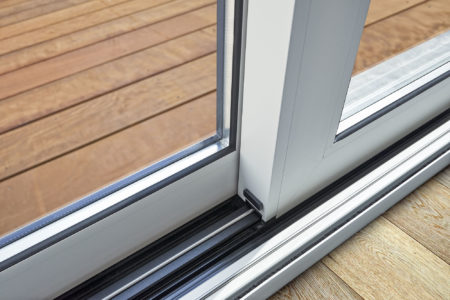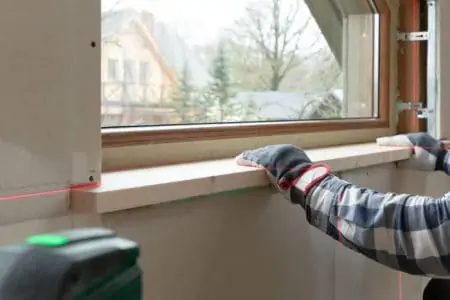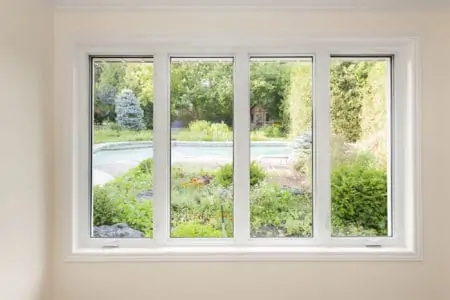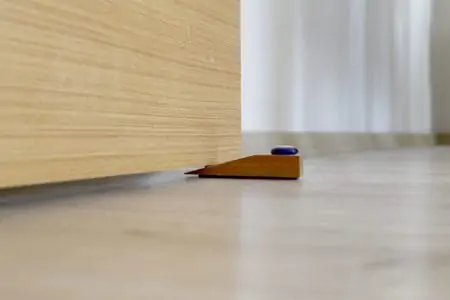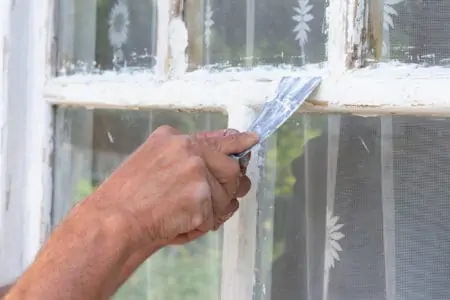Have you ever tried to open a sliding door only to find it’s stuck in place or is very difficult to open? That means you’ll need to learn how to clean sliding door tracks, as the problem is likely dirt buildup.
Cleaning sliding door tracks isn’t complicated, but I want to share a few best practices that will teach you how to maintain your sliding mechanisms in top shape.
Key Takeaways
- Vacuum the tracks to remove dirt and debris.
- Create a cleaning solution of equal parts water and vinegar, and apply it to the tracks along with baking soda.
- Scrub the tracks with a toothbrush or wire brush to remove grime.
- Wipe the tracks clean with a cloth or paper towel, and lubricate with a silicone-based lubricant for smooth operation.
Why is My Sliding Door So Hard to Open?
Sliding doors are commonly seen in patio entrances, shower doors, windows, and sometimes even in living rooms or other rooms of the house.
They are space-saving solutions (since the open door doesn’t take up room space) and are often made from aluminum or some other type of metal.
Before you learn how to clean sliding door tracks, it’s important to know why your doors are hard to open in the first place. There are several reasons why your sliding doors will not open and close the way they used to.
The Tracks are Bent
When this happens, the sliding glass door is unable to move properly. Tracks that are bent inward will squeeze rollers and prevent doors from moving, whilst tracks that are bent outward may cause the door to derail.
While minor bends may frequently be repaired with pliers, more significant damage should be dealt with by a professional.
There’s Dirt in the Tracks
The most typical reasons for a stuck sliding patio door are that it is either clogged with debris or that the rollers need to be replaced.
The Rollers are Dirty
Rollers are the components located at the bottom of sliding doors that enable them to glide effortlessly down their tracks. If you are having difficulty opening and closing the door, it could be simply due to dirt on the rollers.
The Rollers are Rusted or Broken
While salty or humid air is unpleasant on sliding door rollers, restoring these components is fairly challenging. It necessitates the removal of both the sliding and stationary doors.
The Wheels Need Adjusting
If the rollers of a sliding door are not operational, chances are the door will slide off the track. The solution for this is to adjust the screws that hold the wheels in place.
How to Clean Sliding Door Tracks
There are several ways, and we’ll go over each one so you can choose the best method for you.
With Baking Soda
Baking soda is a very commonly used cleaning ingredient. Almost everyone has it in their home. I wanted to share some hacks on how to clean sliding glass door tracks using baking soda and vinegar.
What You’ll Need
- White vinegar.
- Water.
- Baking soda.
- Clean spray bottle.
- Toothbrush or wire brush.
- Paper towel or clean cloth.
- Handheld vacuum.
1. Vacuum the Tracks
Open the door. Using a vacuum cleaner (handheld models are easier to operate in such a scenario), clean the tracks of dirt, debris, dust, pet hair, etc.
2. Make a Cleaning Solution
Take a clean spray bottle and add equal parts of water and vinegar. Shake the bottle to allow these two ingredients to mix.
3. Apply Baking Soda
With the doors open, sprinkle baking soda along the surface of the tracks. If there are any areas with a lot of dirt buildup, feel free to add more baking soda.
4. Apply Cleaning Solution
Take the bottle of cleaning solution you made during the second step and apply it all over the baking soda. The solution should start to fizz. Allow it to sit between five and 10 minutes.
5. Scrub the Tracks
Take your wire brush or toothbrush and start scraping the grime off the tracks. This helps remove dirt and grime. Make sure you scrub on both sides of the door.
6. Wipe the Tracks
Grab a clean towel or a rag and remove any excess dirt and grime. Add more vinegar solution to the tracks if you notice more dirt stains. Scrub until all the dirt has been removed from the tracks.
To Deep Clean Tracks
Cleaning tracks that are very dirty is a matter of putting in some extra elbow grease. Some steps are identical to baking soda track cleaning, but there are a few extra ones to undertake.
What You’ll Need
- Vacuum cleaner.
- Water.
- Clean cup.
- Non-abrasive cleaner.
- Wire brush.
- Vinegar.
- Baking soda.
- Toothbrush.
1. Remove Loose Debris
With the vacuum cleaner, thoroughly clean the tracks until all loose dirt, debris, and grime has been removed.
2. Create First Cleaning Solution
Take a clean cup filled with water and add a few drops of non-abrasive cleaner. Mix the solution. For the best results, use warm water.
3. Scrub the Tracks
Dip the wire brush in the cleaning solution and start scrubbing the tracks. You can use a toothbrush, but a wire brush is better because it covers a larger track area at once.
4. Wipe the Tracks
Grab a paper towel or a clean rag and wipe down the tracks.
5. Vacuum the Other Side
Close the doors and vacuum the tracks of the other doors. Scrub them as you did earlier. Wipe them clean to remove excess moisture and dirt.
6. Create Second Cleaning Solution
In a clean spray bottle, mix equal parts vinegar and water.
7. Clean Tracks with Baking Soda
As you did in the previous tutorial, apply baking soda on the tracks. Spray the vinegar solution and allow it to fizz for up to 10 minutes. Take the wire brush and toothbrush and start scrubbing the tracks once again, then wipe it clean when you’re done.
For Routine Maintenance
Stay on top of the cleaning throughout the year with this tutorial.
What You’ll Need
- Butter knife.
- Toothbrush.
- Cloth.
- Paper towels.
- White vinegar.
- Non-abrasive household cleaner.
- Water.
- Vacuum.
- Clean spray bottle.
1. Vacuum the Tracks
Hand-pick all leaves. Next, sweep up any visible debris. Vacuuming first reduces the work necessary for the next steps.
2. Apply Cleaning Solution
Create a solution by mixing water and white vinegar in a clean spray bottle and spray it along the tracks. Use a dry cloth to clean the surface. Make sure that you’ve removed all moisture from the tracks.
3. Scrub the Grime
Take the toothbrush and scrub any grime that might be on the tracks to loosen any leftover debris. Put a paper towel in the track to soak the liquid entirely.
Take Note
Don’t use any abrasive cleaners on aluminum and metal surfaces. It will leave scratches.
4. Clean the Corners
To clean the jamb, use a butter knife wrapped in a cloth to reach difficult corners. This part should be easy if the previously-applied solution loosened all the dirt.
How to Lubricate a Sliding Glass Door
After your tracks are clean, you may want to apply some silicone-based lubricant. Opt for silicone over oil-based as oil tends to collect dirt more. This will ensure the doors open with ease. I recommend using WD-40’s Water Resistant Silicone Lubricant for the best results.
The process is easy:
- Spray the lubricant on the tracks.
- Wipe the tracks with a dry rag to remove excess.
- Locate the hole on the edge of the door.
- Put the straw attached to the lubricant in that hole and spray. This lubricates the wheels inside the door.
- Open and close the door a few ties to break it in.
Frequency Is Key
You should lubricate your tracks once every two months to make sure they are working smoothly.
How to Remove Rust From Sliding Door Tracks
Since most sliding doors are made from aluminum, they are prone to rust. This will happen when the doors aren’t cleaned regularly. As the rust builds up, your doors become sticky, and you won’t be able to open them.
To remove rust, grab some steel wool to scrub the rust. When you’re done scrubbing, grab a cloth to remove any loose or excess rust.
FAQs
If you’re still unsure, maybe these common questions will help ease your mind.
Conclusion
Once you know how to clean sliding glass door tracks, the process doesn’t seem all that complicated.
It’s important to remember that routine maintenance and cleaning will ensure a longer lifespan for your sliding doors. You will also be able to easily clean your sliding door tracks later on.
